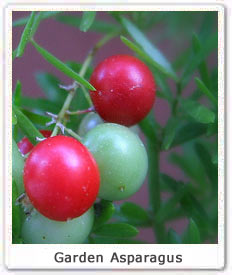| Kingdom : | Plantae |
| Division | Magnoliophyta |
| Class: | Liliopsida |
| Order : | Asparagales |
| Family : | Asparagaceae |
| Genus : | Asparagus |
| Zoological name : | Asparagus officinalis |
| Found In : | Kouchibouguas National Park, Narnala Wildlife Sanctuary and Sariska Tiger Reserve |
Other names : Shatwar, sootmooli, halyan, Satavari, Asparagus root, Wild Aspargus are the other names used for the Garden Asparagus. Satavari means who posses hundred husbands.
Description : Garden Asparagus grows to a height of 3 feet. It is an herbaceous perennial and is well known for its edible young shoots. It has fleshy roots and fern-like feathery foliage. Its roots grows 3 feet down in the soil. Young shoots are green succulent and tender. It has smooth and green
 stems
which are 4-6 feet tall. It has green slender branches which appear more
like the leaves than the branches. It produces male and female flowers on
the separate plants. Flowers are greenish, bell shaped, which grows in the
group of 1 to 3. Round bright red berries are produced on the female plants
and each berries contains several black seeds.
stems
which are 4-6 feet tall. It has green slender branches which appear more
like the leaves than the branches. It produces male and female flowers on
the separate plants. Flowers are greenish, bell shaped, which grows in the
group of 1 to 3. Round bright red berries are produced on the female plants
and each berries contains several black seeds. Other Species : Asparagus aethiopicus, Asparagus africanus, Asparagus declinatus, Asparagus falcatus, Asparagus flagellaris, Asparagus scandens, Asparagus umbellatus, Asparagus plumosus, Asparagus macowanni, Asparagus asparagoides. Garden Asparagus is known to have more than 250 species all over the world.
Location : Garden Asparagus found throughout India especially in the Northern India. It is widely grown in the jungles at an altitude of 8,000 feet. It is mainly grown in the gardens. It can also be found in the Kouchibouguas National Park, Narnala Wildlife Sanctuary and Sariska Wildlife Sanctuary in India.
Cultivation methods :It is mostly propagated through seed, which are allowed to grow for a year. It is mostly planted in the spring season. The plant prefers acid, neutral, and alkaline soil. It grows in semi shade or no shade. The pant is placed in the trench which is 12 -18 inches wide and six inches deep. The roots are spread out uniformly, with the crown bud side up, in an upright, centered position, slightly higher than the roots. It requires water regularly especially when it is young. Young shoots come out in early spring. It flowers in August and the seeds are ripen from September to October.
Medicinal uses : The roots of the plants are prescribed for the diarrhea and dysentery. They are useful in the nervous disorders. dyspepsia, and tumors, scalding of urine, throat infections, tuberculosis, cough, bronchitis and general debility. It is used in the treatment of the rheumatism and edema due to heart failure. The fresh juice taken in small dose acts medicinally as the diuretic and laxative. It an excellent form of folic acid, which is used in blood cell formation and prevention of liver diseases. It is also a good source of potassium, which helps in muscle recovery and prevents cramping. It is rich in Vitamin C, Thiamin, B6 and fiber. It contains rutin, which strengthens capillary walls, and GSH, which is the cancer fighter.
Other uses : The delicate flavour of Asparagus make it favourite among the vegetable lovers. They are normally boiled or steamed. There are so many vegetable recipes made out the Garden Asparagus. Its young shoots are taken as the raw salad. It contains low calorie. It has no fat at all.






